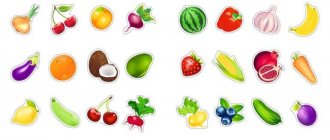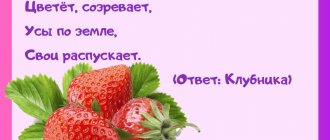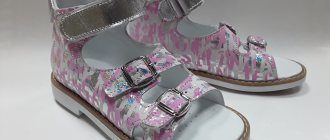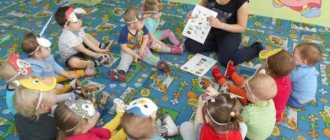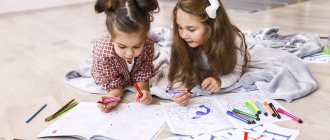If you think that your child is not yet old enough to master the basics of mathematics, then you are deeply mistaken. Various early development methods and a variety of didactic materials not only contribute to the development of mathematical abilities in children, but also instill in them a love for the “queen of the exact sciences.” One of these methods is the development of George Cuisenaire, who forced us to take a fresh look at the counting sticks that are well known to us.
If you think that your child is not yet old enough to master the basics of mathematics, then you are deeply mistaken. Various early development methods and a variety of didactic materials not only contribute to the development of mathematical abilities in children, but also instill in them a love for the “queen of the exact sciences.” One of these methods is the development of George Cuisenaire, who forced us to take a fresh look at the counting sticks that are well known to us.
It is noteworthy that George Cuisenaire managed to create multifunctional didactic material that allows not only to teach children mathematics, but also has a positive impact on the development of fine motor skills, memory, attention, perseverance, visual-effective thinking, imagination, design and combinatorial abilities. At the same time, Cuisenaire sticks can be used both as an independent teaching tool and as additional material to the main early development method.
A few words about George Cuisenaire
Belgian teacher George Cuisenaire is the author of a unique method of early childhood development, having worked in school almost his entire life. Working as a simple teacher in primary school allowed Cuisenaire to put into practice various methods and teaching programs, compare them and “adopt” the most effective and efficient ones. He refined some of the techniques based on his own experience, and described the result in detail in his practical recommendations for teaching children music, geography, art and biology.
Cuisenaire sticks, now famous throughout the world, are also the result of careful refinement. Using the method of his German colleague Friedrich Froebel when teaching children mathematics, Cuisener noted the interest of children and, as a result, the high effectiveness of this method. Froebel's findings formed the basis of Cuisenaire's own method, which was called “Color Numbers.”
Features of the Cuisenaire technique
The classic set of Cuisenaire sticks consists of ten prism sticks ranging from 1 to 10 centimeters in length: the larger the stick, the greater the number value it displays. The colors of the sticks were also not chosen by chance. For example, the numbers of the “red” group of sticks (red, pink and burgundy colors) are multiples of two (2, 4 and 8 centimeters). There are three “blue” groups (blue, cyan and violet colors), and five “yellow” ones. By highlighting the color and length of the sticks, the child begins to understand during the process of manipulation that the number is the result of counting and measurement.
In addition, the volume of the sticks and their identification by color and length allows the baby to master sensory standards (size and color), as well as ways of recognizing and comparing objects by width, height and length. Using Cuisenaire's counting sticks, it is very easy to bring a child to the awareness of such relationships as long-short, right-left, more-less, same-different, high-low, etc.
The main distinctive feature of Cuisenaire colored numbers is that the child masters the simplest mathematical concepts in a playful way. This means that he will associate mathematics with a fun and exciting activity, allowing him to show his imagination and creativity. Note that the author himself recommended starting classes using his method with children aged 1 year. At the same time, he emphasized more than once (and practice has proven this) that his development will be equally interesting for both children aged 1-2 years and schoolchildren aged 8-9 years.
Teaching a child is a complex process, so the availability of additional tools and techniques is an excellent help in obtaining a good result. The process of mastering speech does not present significant difficulties, since it is developed daily in the process of growth and development of the child, but learning to count is the next stage, which will require didactic techniques. The most convenient and proven method of working with children using Cuisenaire sticks, which is not difficult to master if you know the basic laws of the process.
Characteristics Cuisenaire counting sticks have been known for quite a long time and are still popular due to the effectiveness of this technique.
Thanks to the Belgian scientist George Cuisenaire, a set of counting sticks was created, with the help of which it was possible to easily develop mathematical abilities in children.
The advantages of this technique include the full intellectual development of the baby, which has a positive effect on all his other skills.
Cuisenaire sticks can be used from the age of two and can be used until the age of nine.
In the set you can find 116 sticks, numbers and numbers from one to twenty and mathematical symbols.
A special feature of this set is that the sticks in it differ in size and color, which allows you to quickly associate the desired number with a specific color:
the first is the smallest stick and its color is white; the second largest stick is pink; the third largest stick is blue; the fourth stick is red; the fifth stick is yellow; sixth – purple; the seventh largest is black; eighth – burgundy; ninth – blue; the largest stick is colored orange.
The presence of a large number of components allows you to use different games and schemes for children of different ages. Modern didactic systems offer games for preschoolers, primary and secondary school children.
With the help of Cuisenaire sticks, it is possible to speed up the process of learning mathematics and make classes more interesting and varied.
History of the technique The appearance of Cuisenaire sticks is associated with the works of George Cuisenaire, who was puzzled by the problem of teaching children the basics of mathematics. The biography of this Belgian teacher, who lived from 1891 to 1976, boils down to the fact that for most of his life he worked with primary school students and taught them mathematics.
Problems with schoolchildren mastering this science aroused his interest and gave rise to a desire to help children and make learning easy and interesting. Through studying the problem, George Cuisenaire was able to understand that children learn much faster if they have the opportunity to visualize objects and carry out computational operations directly with them.
In addition to visualization, the methodology is based on the principle of play, which allows you to work with children in an easy and relaxed atmosphere, maintaining a stable interest in learning.
To ensure that training went in the right direction and brought results, Cuisenaire additionally studied the methods of Maria Montessori and Friedrich Flebel. Such thorough work was not in vain, since in addition to the sticks, Cuisenaire also compiled detailed instructions for their use. In his book “Numbers and Colors,” he reveals in detail the essence of all the schemes presented in a playful form, according to which children, together with teachers or parents, can master the basic concepts of mathematics.
Pros and cons Any teaching method developed for children has its advantages and disadvantages, and the more positive aspects, the more effective the learning process is. The process of using Cuisenaire sticks also has its pros and cons.
The positive points include the following:
the ability to use didactic material with children of different ages, changing tasks and complicating them as necessary; the presence of a large number of diagrams, game scenarios, albums that will help you easily master the methodology and teach your child mathematics; in addition to working on mathematics, the child develops fine motor skills, imagination, spatial and visual perception; Thanks to the variety of sticks, the child can become more fully familiar with the shapes and colors of objects.
The presence of so many positive aspects allows us to assert that Cuisenaire managed to find the most optimal solution for how to quickly and interestingly teach children mathematics.
His technique works both independently and in combination with other programs to enhance the final result.
Among the shortcomings, we can only highlight the fact that work with counting sticks must be carried out constantly and systematically, otherwise it will not be possible to achieve the desired result.
Suitable age You can practice Cuisenaire sticks with your child from an early age; the most optimal age is 2-3 years, when the baby can understand what exactly they want from him. You can try your hand at mastering the technique with one-year-old children, but this will not bring the desired effect, but the health risk increases significantly due to the presence of small parts in the set.
The most suitable category of children who will be able to master the tasks and gain certain basic knowledge is the preparatory group of the kindergarten. In preparation for school, children should master the concepts of length, color, shape, and have at least a minimal knowledge of how to perform addition and subtraction.
For younger children, game albums have been developed in which sticks of a certain color must be laid out according to given patterns.
The youngest students will learn to separate the concepts of “one” and “many” and understand the difference between “high” and “low.” Older children are offered game albums, game situations and sets of games, which will allow them to master the orientation of objects in space, compare them in terms of length and width, distinguish quantities and learn to count. Each age stage has its own set of schemes and games that allow you to develop logical and spatial thinking.
Similarities and differences with Dienesh In addition to Cuisenaire, other scientists studied the problem of mastering mathematics by young children.
One of the most prominent was Zoltan Dienes, who was interested in mathematics from childhood and by the age of twenty-three had defended his doctorate in it.
In addition to his interest in science itself, Dienesh was interested in studying the thought processes of children while mastering mathematics, for which he studied psychomathematics.
The basis of the Dienesh method is very similar to Cuisenaire sticks, as it consists of learning mathematics through exciting logic games using visual material. The child must solve problems using three-dimensional geometric block shapes. Such activities allow you to develop memory, imagination, attention and logic. With the help of didactic material, children's speech improves, they learn to compare figures by size, quantity and color, and master the basics of classifying objects according to certain characteristics.
In addition to similar features, there are also significant differences between the methods of Cuisenaire and Dienesh, since the sticks differ in color and each is assigned a certain length, while the thickness is the same. Zoltan has 48 colored blocks in his set, they differ in:
color – the set contains blue, yellow and red figures; shape - available in rectangles, squares, triangles and circles; thickness - figures can be either thin or thicker; size - parts have large and small dimensions.
Each of the above methods is useful for teaching children mathematics, allowing them to simultaneously develop other cognitive areas, which contributes to a complete learning process. Despite the similar essence of the methods, the process of presenting them is significantly different, so it is worth trying both options and choosing the one that the children will understand better.
Purpose of use Cuisenaire rods are used in working with preschoolers and children of primary and secondary school levels. The tasks for each age stage will be different, but in general they come down to the following list:
acquaintance with numbers in a playful way; assistance in developing ideas about counting and color; developing interest in mathematical sciences; development of logical thinking, formation of the ability to make non-standard decisions; assistance in mastering basic mathematical operations: addition and subtraction; mastering the difference between quantitative and ordinal counting; developing the skill of measuring comparison by length, width and height; consolidation of knowledge about geometric shapes by laying them out using sticks from the set.
Thanks to a set of Cuisenaire sticks, it is possible to comprehensively develop a personality, while developing a strong interest in the exact sciences, as well as make classes educational and non-standard. Classes with this didactic set allow the child to use their imagination, find a solution to a problem in a non-standard way, while training not only the brain, but also fine motor skills of the hands.
Children who study using this method become more restrained, diligent, observant and patient.
Games The process of teaching children mathematics is carried out with children of preschool and primary school age, the main method is the game. In the younger group of the kindergarten, large figures are used: cubes, mosaics, geometric blocks. At this age, Cuisenaire sticks are given for familiarization as play material, so that children get used to them and learn to work with them. In the middle group, you can safely teach simple games with a set of sticks, in which you need to fold something from them, find an option that is suitable in color or size.
Classes in the senior group are the most varied, as they prepare the child for school, maximizing his mathematical potential. When working with preschoolers, a teacher or parent must clearly understand their role in the educational process. The little ones need to be shown and told everything, all the while watching the children play.
In the middle group, it is worth giving games and tasks, stipulating the result; in this case, it is important to give freedom of action, without limiting the child, but pushing him to think outside the box, creatively and look for different ways to solve the problem.
For children in the older group, it is enough to distribute didactic material and set them a task that they must cope with independently.
In order to choose the right games and tasks for children of different ages, you should focus on age gradation, which regulates the level of difficulty and duration of classes
From 2 to 3 years To make learning mathematics more interesting and simpler, it is worth using teaching materials such as:
game album “it’s fun to play together”; album-game “magic paths for the little ones.” Thanks to such educational games, you can familiarize children with the variety of colors, make them understand the difference between “one” and “many”, as well as “high” and “low”. With the help of bright handouts, children can quickly remember the correspondence between the length and color of the stick, learn how to use them, carefully laying out a given picture.
From 3 to 5 years old To develop the mathematical abilities of children in the middle group, it is best to use such teaching aids as:
a set of games “on the golden porch”; educational game situations “fun colored numbers”; album-game “house with a bell”. Thanks to these classes, children will quickly learn the difference between objects in height and width, position in space, remember the color and digital designation of sticks and be able to quickly identify them.
Thanks to activities with sticks, children 3-5 years old will be able to learn the basics of counting and try their knowledge in practice. Additional games will provide an opportunity to learn to compare different objects, finding similarities and differences in them. In the “fun colored numbers” set, in addition to task cards, there are also colored strips that can be cut out and, if necessary, used instead of sticks.
From 5 to 7 years old In preparing children for school, it is best to use teaching aids:
a set of games “on the golden porch”; set of games "Crostika's china shop". Thanks to working with this material, it is possible to improve children’s knowledge regarding the color, size, length and thickness of objects, and their orientation in space.
There will be new exercises where you need to lay out an object along a contour, which will not only improve fine motor skills, but also familiarize children with symmetry and the basics of working on a coordinate system.
More difficult tasks will be options where you need to independently lay out the drawing given in the picture, without using a sample. For those children who consistently cope with the work and demonstrate good mathematical abilities, you can give encrypted cards on which the size and color of the sticks are not indicated, but only a number, according to which the child himself must choose the desired option and get the correct picture.
Modeling fairy tales In the process of teaching children one subject, one should not forget about the development of other skills. Thus, Cuisenaire sticks and Dienesh blocks can be useful for speech development. In the process of reading fairy tales, some children may experience difficulties in remembering the plot, main characters, and the outcome of the work.
To help children and improve their memory and speech, you need to print out your favorite fairy tale and pictures for it, which will serve as background material for the lesson.
After reading the fairy tale and showing the pictures, the teacher or parent should designate each character with a stick of a certain color or block, which will allow for some kind of association and reinforcement of the material read.
Blocks and sticks must correspond in a certain way to the essence of the work, for example, if we are talking about a wolf, it is worth using a black stick for it, since this is a negative character, positive characters should be designated with light sticks, and the cubs should be the smallest. Thanks to the correlation of auditory, visual and tactile perceptions, the child grasps the essence of the fairy tale much faster and does not have problems interpreting it.
Construction In addition to specific goals and tasks that require children to obtain the only correct result, with the help of Cuisenaire sticks they can develop imagination and orientation in space. The teacher or parent must set a goal, and the child will try to implement it on his own, and the more original the solution, the better.
There is no need to set any boundaries; flights of fancy should be the main thing in the process, especially when it comes to the younger and middle groups of preschoolers.
Construction in the senior group and junior school will already have more correct final results, although creativity in completing the task should be encouraged. With the help of Cuisenaire sticks, you can create objects, animals, toys, everything that surrounds the child every day, is familiar to him and will not cause difficulties in designing with the help of sticks. The use of this didactic set allows not only to develop imagination, but also to think creatively, rationally evaluate real objects and accurately reproduce the final result.
How to do it yourself? The presence of Cuisenaire sticks will be useless without the ability to work with them, so the task book will become a fundamental link for getting started. After reading all the games and understanding the tasks, you can purchase a ready-made set of sticks or cut out a template from cardboard that will help you out for the first time. It’s not difficult to make such handouts; the main thing is to find cardboard in the right colors and cut out strips of the required length. When creating sticks yourself, you should not make it easy for children and sign numbers on them, as this will have the opposite effect.
It will be much more difficult to create three-dimensional sticks on your own, but with desire and certain skills it is quite possible. If the mother is just introducing the baby to the Cuisenaire technique, then you can choose similar objects that will differ in length and color.
When playing with three-dimensional objects, the baby will develop through tactile touches, and in adulthood, cardboard sticks will be no less effective than specially made ones.
The benefits and benefits of working with children for mastering the exact sciences and mathematics in particular thanks to the work of Cuisenaire and Dienesh are obvious; the main thing is to be able to correctly present the material and conduct classes systematically.
How are classes conducted using the Cuisenaire method?
Classes using the Cuisenaire method can be divided into two stages:
- play - sticks are used as material for games (the baby plays with them as with the most ordinary cubes or mosaics: builds ladders or lays out figures). During the game, the child develops visual perception and fine motor skills. By commenting on the child's games, adults help him become familiar with the colors and sizes of sticks.
- educational - act as a universal mathematical aid that allows a child to form the concept of a numerical sequence and the composition of a number “through the hands” (that is, visually). The choice of exercises using Cuisenaire counting sticks
is carried out taking into account the level of development and capabilities of children, as well as their interest in solving certain problems. For example, for younger children, you can offer tasks in the form of game motivation (fix a fence, build a ladder, etc.). For older children, you can choose tasks in the form of competitions (who can build a labyrinth faster, find the right number, etc.).
Classes using the Cuisenaire method are greatly facilitated by special manuals with bright drawings and diagrams designed for different age categories of children, which can be found in almost any store specializing in the sale of educational games.
Cuisenaire rods: description of the methodology, history and purpose of creating counting exercises
In 1952, a mathematical manual for preschoolers and primary schoolchildren was published. It was created by the Belgian mathematician George Cuisenaire. During learning, a child uses all his senses, so the method is based on the tactile mastery of some mathematical abstract concepts - orderliness, set, identity.
A colleague of the Belgian mathematician, the French scientist and philosopher Caleb Gateno, made this manual popular and for the first time began using colored counting sticks to teach children mathematics and various languages. A child, mastering one science, simultaneously develops other abilities. He will be able to identify logical connections in speculative concepts, learn to use imagination and abstract thinking.
The Cuisenaire rod technique has several goals:
- The child develops a specific counting system;
- the concept of larger and smaller numbers develops;
- skills of addition and subtraction, multiplication and division appear;
- children distinguish between the right and left sides, learn to determine the middle;
- creativity, creative inclinations, modeling and design skills develop;
- cognitive character, visual and effective methods of thinking are manifested, all types of attention are sharpened, the environment is perceived in more detail;
- fine motor skills of the hands improve.
The age for starting classes is determined individually, it depends on the development of the child. But usually the first lessons are given to three-year-old children. Although some teachers advise developing them from the age of one, teaching them to solve mathematical problems with colored sticks.
Disadvantages of the Cuisenaire technique
Almost all experts unanimously claim that Cuisenaire sticks have no disadvantages. Today, this didactic material is one of the best and most effective tools for introducing children to mathematics from a very early age. The opinion of experts is also confirmed by numerous enthusiastic reviews from parents who are already practicing the Cuisenaire method at home.
But, as you know, even in honey you can find a fly in the ointment. “Colored numbers” were no exception. The proverbial “fly in the ointment” can be considered the need for systematic joint (parents and children) activities with counting sticks. Otherwise, the effect will be practically unnoticeable.
Subscribe to our Telegram to stay up to date with important news in the field of education.
